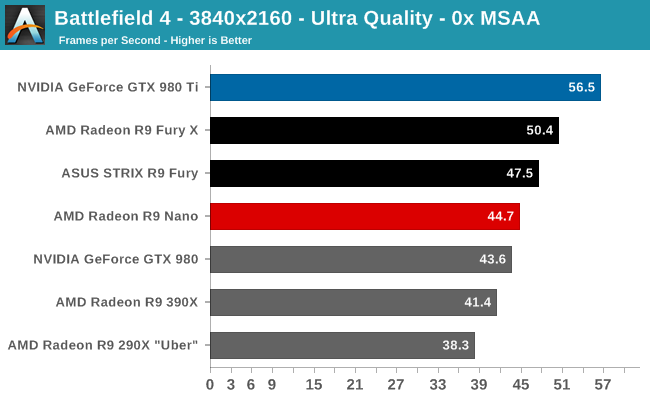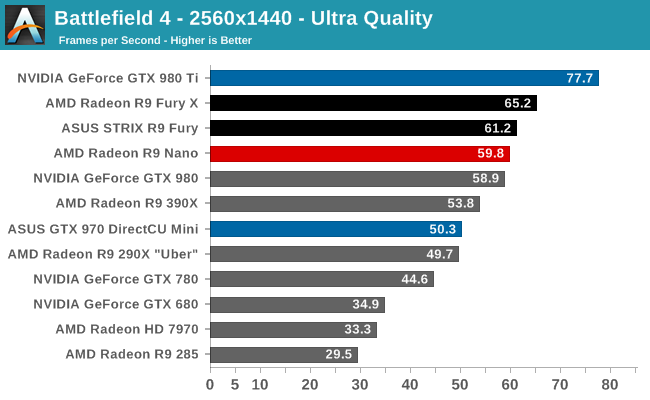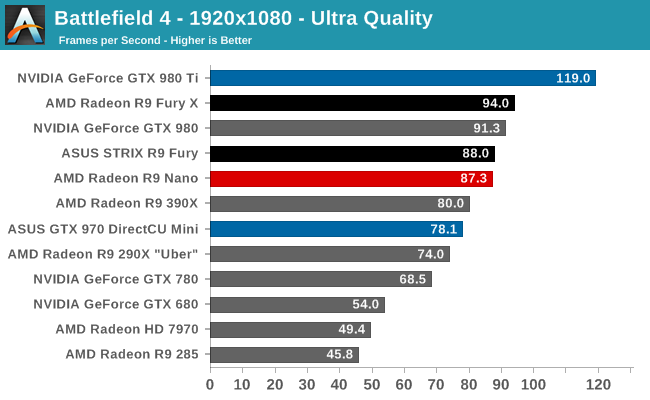The AMD Radeon R9 Nano Review: The Power of Size
by Ryan Smith on September 10, 2015 8:00 AM ESTBattlefield 4
Kicking off our benchmark suite is Battlefield 4, DICE’s 2013 multiplayer military shooter. After a rocky start, Battlefield 4 has since become a challenging game in its own right and a showcase title for low-level graphics APIs. As these benchmarks are from single player mode, based on our experiences our rule of thumb here is that multiplayer framerates will dip to half our single player framerates, which means a card needs to be able to average at least 60fps if it’s to be able to hold up in multiplayer.




Like the other Fiji cards, AMD is promoting the R9 Nano in part on its 4K capabilities. And while we disagree that this card is suitable for 4K gaming based on its sub-Fury performance, we’re including 4K results anyhow to serve as a point of comparison.
In any case Battlefield 4 is often a good indicator of general card performance, and for the R9 Nano this is no exception. What we find is that the R9 Nano trails the other Fury cards in all cases. However to our initial surprise, the R9 Nano sticks rather close to the R9 Fury. The petite powerhouse trails the R9 Fury by only 1-6%, which for the record is a smaller gap than we were expecting.
While the R9 Nano packs a full Fiji GPU, AMD has to pull back on clockspeeds to hit their power targets; in the case of Battlefield 4 this is an average clockspeed of just 879MHz at 2560x1440. Given this we had been expecting the R9 Nano to deliver around 85-90% of the performance of the R9 Fury (and about 80% of the R9 Fury X), based on the assumption that average clockspeeds would be closer to 800MHz. So the fact that the R9 Nano starts off as close to the R9 Fury as it does – even if it’s still trailing it – is a pleasant surprise.
Otherwise with performance still clearly occupying a position as a “3rd tier” Fiji card, I’m not sure if anything about these results should be surprising. On a price/performance basis AMD is not intending to be competitive with other $650 cards, so the R9 Fury X and GTX 980 Ti are of course on the top of the heap. What you get instead is a card that delivers around 90% of R9 Fury X’s performance in BF4 with much less power consumption.
Moving on, compared to the lower power and smaller cards, the R9 Nano is as expected a clean sweep. Demonstrating the virtues of a wide and lower clocked processor’s ability to deliver strong performance without requiring extreme power, everything from the R9 285 to the GTX 980 trails the R9 Nano here. Compared to the GTX 970 Mini in particular, the R9 Nano is 12-26% faster depending on the resolution.
The one potential problem here for the R9 Nano is the GTX 980. Though not a Mini-ITX card, the GTX 980’s power consumption is going to be fairly close to the R9 Nano’s, definitely more so than GTX 970’s. From a power efficiency standpoint it’s the GTX 980 that poses the greatest challenge to the R9 Nano, and while it’s ahead of the GTX 980 in this case at 2560x1440 and higher, it’s a sign that AMD should be worried about what could happen if an NVIDIA partner produced a Mini-ITX GTX 980.










284 Comments
View All Comments
itproflorida - Friday, September 11, 2015 - link
"As these benchmarks are from single player mode" haha,Kutark - Thursday, September 10, 2015 - link
I think *overall* AMD has a win with this as they've found a market (albeit small) that they can fill with a product without competition.This does lead me to wonder, what can Nvidia do? We know maxwell 2 is a little more power efficient than fiji... could they do a similar binning and back a GM200 chip down a 100mhz or so at a 175w tdp and produce similar results in a similar sized package? I know the HBM makes it a bit easier for the small form factor, but i don't think people will cry over half an inch longer board for an nvidia card in the same market.
Peichen - Friday, September 11, 2015 - link
GTX980 is already a 175W card. Reference GTX980 have the same power plug requirement as the Nano.slapdashbr - Friday, September 11, 2015 - link
nVidia isn't pushing (as far as I know) any of it's AIB partners to do this, but: gigabyte could just make a gtx 980 on the same PCB as that 970 mini. The 980 only uses what, 165W? 180 maybe? it's roughly on par with the nano to be honest, and with the fairly low power draw I really don't see why you can't have a 980 on a shorter card. Honestly an ITX-size 980 was what I wanted as soon as they were announced, for god's sake, the r9-380 can draw more juice than a 980 and those are available in ITX form factor.Kutark - Friday, September 11, 2015 - link
Fair point. I still wonder though if they did a GM200, basically a 980ti thats backed down on clock rates to meet a lower TDP, what it would look like.medi03 - Saturday, September 12, 2015 - link
There is more to it: that HBM memory thing allows for more compact designs.extide - Monday, September 14, 2015 - link
Well yeah, but there are already ITX sized cards out there with GDDR5 (GTX 970, R9 380, etc) so it's obviously possible. PCB might be a little bit bigger but it can still be ITX sized.Kutark - Wednesday, September 30, 2015 - link
Not *that* much more compact. From what i understand we're talking about half an inch or so shorter because of the HBM.Jm09 - Thursday, September 10, 2015 - link
I wish amd would of released a nano and a nano-x with this choice being the nano x as its a binned full Fiji chip. I think an r9 nano competing in the $400 range would of been a huge hit, and raise brand perception which amd needs a ton of right now.Peichen - Friday, September 11, 2015 - link
Nano is the full chip. It just runs at a lower clock than Fiji X and Fiji, the actual trimmed card.